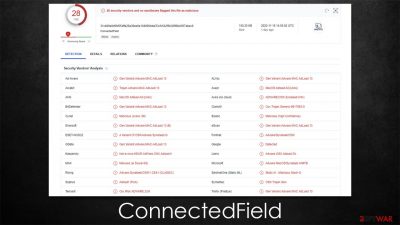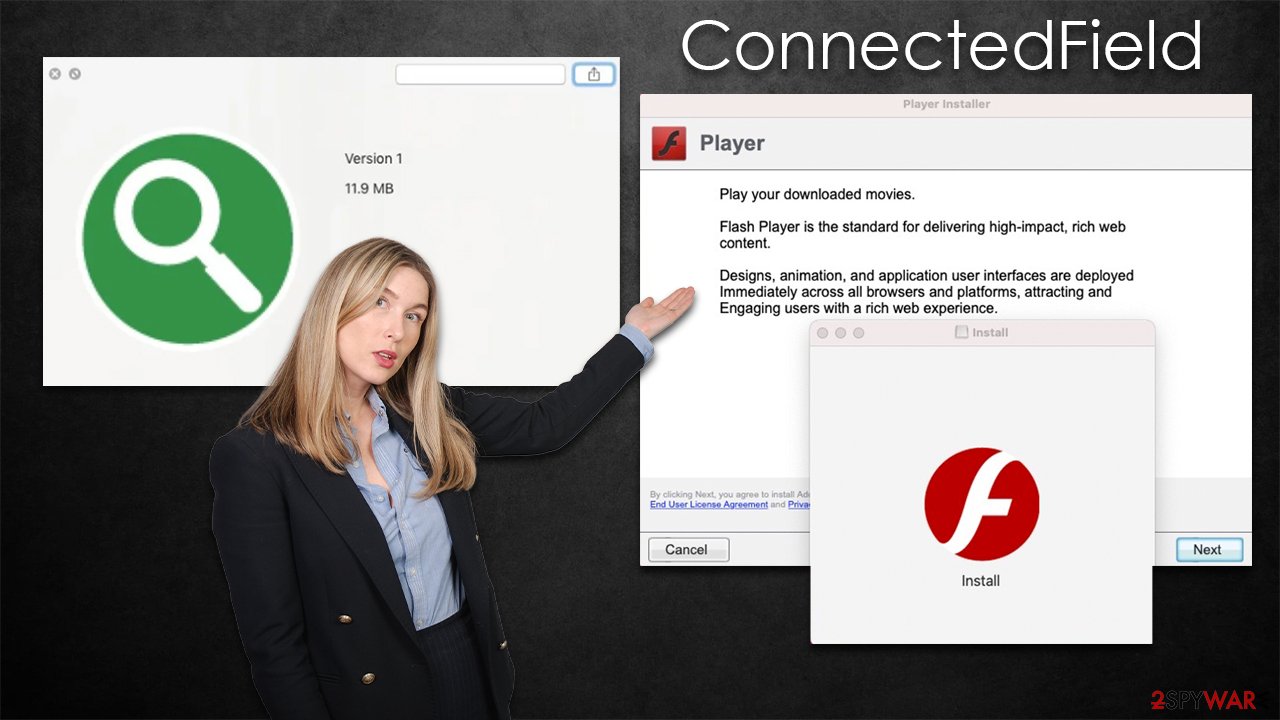ConnectedField Mac virus (Free Guide)
ConnectedField Mac virus Removal Guide
What is ConnectedField Mac virus?
ConnectedField is a type of Mac malware that stems from a prominent adware strain

ConnectedField is a malicious application that you may install accidentally – either after being tricked by a fake Flash Player installer or downloading it in a bundle from sites that distribute software cracks and similar illegal apps.
While most users do not notice the infiltration right away, the feeling that something's wrong is usually felt after the browser is opened, as searches and other operations suddenly change. For example, the homepage and new tab might be set to Safe Finder, and the search results would be provided by Yahoo or another provider. These symptoms are now always present, and sometimes the only thing people notice is the presence of the ConnectedField extension and the app.
Behind the scenes, the virus collects various information users type into the browser, including passwords, credit card info, and other personal details. In some cases, users might find additional versions of Adload (a strain the virus comes from) installed on their devices without consent, e.g., InitialConnection or CharacterGeneration.
Finally, many people may struggle with ConnectedField removal, as it might reinfect the machine once again, and extension uninstallation might not be possible in a regular manner. Thus, please follow the instructions below to get rid of this rather dangerous infection as soon as possible.
| Name | ConnectedField |
| Type | Mac virus, adware, browser hijacker |
| Malware family | Adload |
| Distribution | Users typically get infected after being tricked by a fake Flash Player update, although repacked installers from torrent sites can also be the cause of infection |
| Symptoms | Installs a new extension and application on the system; changes homepage and new tab of the browser; inserts ads and malicious links; tracks sensitive user data via extension |
| Risks | Installation of PUPs or malware, sensitive information disclosure, financial losses |
| Removal | The easiest way to remove Mac malware is to perform a full system scan with SpyHunter 5Combo Cleaner security software. We also provide a manual guide below |
| Other tips | For best performance and system remediation, employ FortectIntego. Also, cleaning web browser caches is highly advised after the elimination of malware for better privacy and security |
Dangers of ConnectedField virus
ConnectedField is often classified as adware[1] because it causes advertisements to appear in the browser or through other means. But it is more than an irritating program – it's capable of taking actions that a regular adware application shouldn't be able to do; hence, it is commonly referred to as malware by security programs and researchers.
The virus's primary objective is to show advertisements and generate pay-per-click revenue, but it also benefits from several other supporting elements. For example, the use of AppleScript allows the infection to completely avoid detection from built-in Mac defenses like XProtext and Gatekeeper.[2] This is why it's critical to ensure that your system has additional security measures in place.

The ConnectedField virus installs itself on Safari or another browser with the help of permissions that are granted upon installation by the user. Once installed, it takes over users' browsing sessions immediately. If someone tries to remove the app, they would likely see the extension grayed out within the settings menu, leaving them stuck with it. In the meantime, The app could collect various personal information from users without their knowledge or consent, putting privacy at risk.
Malware removal explained
ConnectedField is especially difficult to remove because it runs on a system with elevated permissions. Not only does it drop several files, but it also creates new profiles and login items. With the help of built-in AppleScript, malware can completely bypass removal from Mac's built-in defense systems and continue operating even if the main app or/and extension are removed.
For these reasons, we advise terminating the infection automatically with Malwarebytes or SpyHunter 5Combo Cleaner security software. However you choose to delete it, though, we again propose clearing web browser caches to stop troubles from happening down the line.
If you would rather attempt to eliminate the infection yourself, you should keep in mind that the background process might interfere with this attempt. Thus, launch the Activity Monitor and shut them down first:
- Open Applications folder
- Select Utilities
- Double-click Activity Monitor
- Here, look for suspicious processes and use the Force Quit command to shut them down
- Go back to the Applications folder
- Find the malicious entry and place it in Trash.
![Uninstall from Mac 1 Uninstall from Mac 1]()
Login items are used to make apps start as soon as the computer is turned on, and Profiles help manage different account settings. You can get rid of these malicious components by following these steps:
- Go to Preferences and pick Accounts.
- Click Login items and delete everything suspicious.
- Next, pick System Preferences > Users & Groups.
- Find Profiles and remove unwanted profiles from the list.
The PLIST files are small config files, also known as “Properly list.” They hold various user settings and hold information about certain applications. To remove the virus, you should find the related PLIST files and delete them as follows:
- Select Go > Go to Folder.
- Enter /Library/Application Support and click Go or press Enter.
- In the Application Support folder, look for any dubious entries and then delete them.
- Now enter /Library/LaunchAgents and /Library/LaunchDaemons folders the same way and terminate all the related .plist files.
![Uninstall from Mac 2 Uninstall from Mac 2]()
Taking care of the browser
The ConnectedField extension is necessary for the virus to function properly. It alters essential browser settings (homepage, new tab address, and search provider) to make sure users are exposed to ads constantly. Additionally, it allows malware access to read and store data typed into the browser, which no doubt can be a major security breach.
If you followed the automatic steps to get rid of the browser extension, it should be gone by now, and you shouldn't worry about it. If you decided on the manual solution, double-check that the extension is deleted using these instructions:
Safari
- Click Safari > Preferences…
- In the new window, pick Extensions.
- Select the unwanted extension and select Uninstall.
![Remove extensions from Safari Remove extensions from Safari]()
Google Chrome
- Open Google Chrome, click on the Menu (three vertical dots at the top-right corner) and select More tools > Extensions.
- In the newly opened window, you will see all the installed extensions. Uninstall all the suspicious plugins that might be related to the unwanted program by clicking Remove.
![Remove extensions from Chrome Remove extensions from Chrome]()
The next thing on your to-do list should be clearing Safari or any other browser caches, including cookies[3] that are used so frequently to track people. If you use the FortectIntego maintenance tool, you can easily and efficiently get rid of outdated files and trackers rather than having to do it yourself.
Safari
- Click Safari > Clear History…
- From the drop-down menu under Clear, pick all history.
- Confirm with Clear History.
![Clear cookies and website data from Safari Clear cookies and website data from Safari]()
Google Chrome
- Click on Menu and pick Settings.
- Under Privacy and security, select Clear browsing data.
- Select Browsing history, Cookies and other site data, as well as Cached images and files.
- Click Clear data.
![Clear cache and web data from Chrome Clear cache and web data from Chrome]()
Finally, you may have noticed that the virus' browser extension has returned, or you were not able to eliminate it in the first place. If that's the case for you, you should opt for a full browser reset.
Safari
- Click Safari > Preferences…
- Go to the Advanced tab.
- Tick the Show Develop menu in the menu bar.
- From the menu bar, click Develop, and then select Empty Caches.
![Reset Safari Reset Safari]()
Google Chrome
- Click on Menu and select Settings.
- In the Settings, scroll down and click Advanced.
- Scroll down and locate Reset and clean up section.
- Now click Restore settings to their original defaults.
- Confirm with Reset settings.
![Reset Chrome 2 Reset Chrome 2]()
How to prevent from getting adware
Choose a proper web browser and improve your safety with a VPN tool
Online spying has got momentum in recent years and people are getting more and more interested in how to protect their privacy online. One of the basic means to add a layer of security – choose the most private and secure web browser. Although web browsers can't grant full privacy protection and security, some of them are much better at sandboxing, HTTPS upgrading, active content blocking, tracking blocking, phishing protection, and similar privacy-oriented features. However, if you want true anonymity, we suggest you employ a powerful Private Internet Access VPN – it can encrypt all the traffic that comes and goes out of your computer, preventing tracking completely.
Lost your files? Use data recovery software
While some files located on any computer are replaceable or useless, others can be extremely valuable. Family photos, work documents, school projects – these are types of files that we don't want to lose. Unfortunately, there are many ways how unexpected data loss can occur: power cuts, Blue Screen of Death errors, hardware failures, crypto-malware attack, or even accidental deletion.
To ensure that all the files remain intact, you should prepare regular data backups. You can choose cloud-based or physical copies you could restore from later in case of a disaster. If your backups were lost as well or you never bothered to prepare any, Data Recovery Pro can be your only hope to retrieve your invaluable files.
- ^ Adware. Investopedia. Source of financial content on the web.
- ^ Phil Stokes. Massive New AdLoad Campaign Goes Entirely Undetected By Apple’s XProtect. SentinelLabs. Security research blog.
- ^ Cookies and Web Beacons. NTT. NTT Communications.








